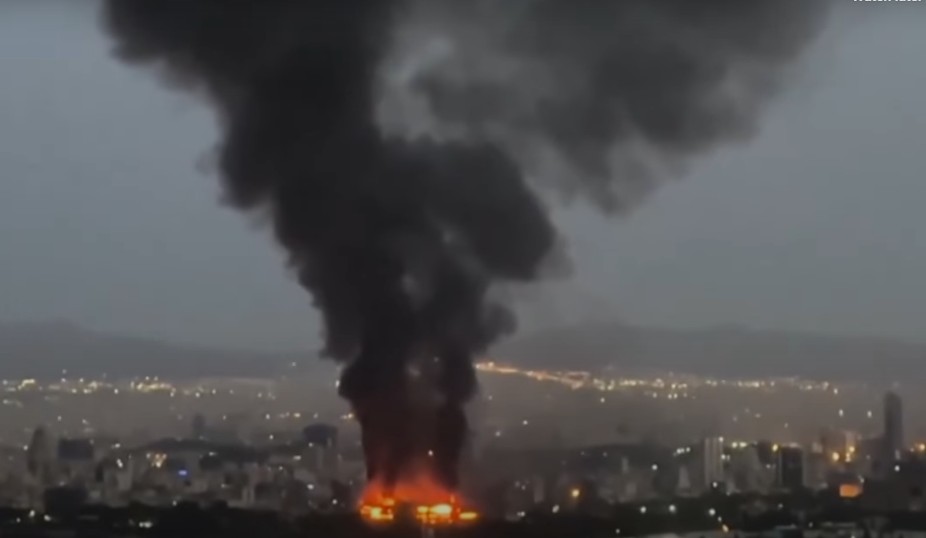Intense Israeli airstrikes targeted Iran’s capital early Wednesday after it issued a warning about a new area it could target, a day after U.S. President Donald Trump demanded “unconditional surrender.” Uncertainty roiled the region and residents of Tehran fled their homes in droves on the sixth day of Israel’s air campaign aimed at Iran’s military and nuclear program.
As the US sent warplanes to the Middle East, Trump warned Supreme Leader Ayatollah Ali Khamenei that the US knows where he is hiding and called for Iran’s “UNCONDITIONAL SURRENDER” in a post online, without elaborating. Trump posted that there were no plans to kill Khamenei “at least not for now.”
The UN nuclear watchdog also said for the first time that Israeli strikes on Iran’s main uranium-enrichment facility at Natanz had damaged its main underground centrifuge facility, not just an above-ground facility. Israel asserts its sweeping assault is necessary to prevent Iran from getting any closer to building an atomic weapon. The strikes have killed at least 224 people in Iran. Iran has retaliated by launching some 400 missiles and hundreds of drones at Israel. So far, 24 people have been killed in Israel.
Israel hammers Tehran
A major explosion could be heard around 5 a.m. in Tehran Wednesday morning, following other explosions that boomed earlier in the predawn darkness. Authorities in Iran offered no acknowledgement of the attacks, which has become increasingly common as the Israeli airstrike campaign has intensified since they began on Friday. The Israelis earlier warned they could strike a neighborhood south of Mehrabad International Airport, which includes residential neighborhoods, military installations, pharmaceutical companies and industrial firms.
Israel also claimed that it had killed Iran’s Gen. Ali Shadmani, whom Israel described as the country’s most senior remaining military commander, in Tehran. Shadmani was little known in the country before being appointed last week to a chief-of-staff-like role as head of the paramilitary Revolutionary Guard’s Khatam al-Anbiya Central Headquarters following the killing of his predecessor, Gen. Gholam Ali Rashid, in an Israeli strike.
Trump demands Iranian surrender
Trump left the Group of Seven summit in Canada a day early to deal with the conflict between Israel and Iran, telling reporters: “I’m not looking at a ceasefire. We’re looking at better than a ceasefire.”When asked to explain, he said the US wanted to see “a real end” to the conflict that could involve Iran “giving up entirely.” He added: “I’m not too much in the mood to negotiate.”
Despite warning that US “patience is wearing thin,” he indicated that diplomatic talks remained an option, and said he could send Vice President JD Vance and special envoy Steve Witkoff to meet with the Iranians. Meanwhile, the US is shifting military aircraft and warships into and around the Middle East to protect Israel from Iranian attacks and respond to Iran’s threats to target US military installations.
Satellite images analyzed Wednesday by The Associated Press appeared to show no vessels anchored off the headquarters of the US Navy’s 5th Fleet in Bahrain. Dispersing ships is a common safety technique employed by navies around the world in times of trouble. Trump and Israeli Prime Minister Benjamin Netanyahu spoke about the evolving situation over the phone on Tuesday, according to a White House official who was not authorized to comment publicly and spoke on the condition of anonymity.
Iran vows further attacks
Iran offered no immediate response to the president’s posts, but the country’s military leaders vowed that Israel would soon see more attacks. “The operations carried out so far have been solely for the purpose of warning and deterrence,” Gen. Abdul Rahim Mousavi, the commander in chief of Iran’s army, said in a video. “The punishment operation will be carried out soon.”
Israel’s military warned the population to stay close to shelters as Iran fired new salvos of missiles Wednesday, but officials said most were intercepted and Israel’s rescue services had no immediate reports of injuries. Sirens blared in southern Israel, including in the desert town of Dimona, the heart of Israel’s never-acknowledged nuclear arms program. The US State Department announced that the US Embassy in Jerusalem will remain closed through Friday due to “the current security situation and ongoing conflict between Israel and Iran.”
Nuclear agency reports more damage to enrichment site
The International Atomic Energy Agency said it believed that Israel’s first aerial attacks on Iran’s Natanz enrichment site had directly affected the facility’s underground centrifuge facility. Satellite imagery collected after Friday’s attacks showed “additional elements that indicate direct impacts on the underground enrichment halls,” the watchdog said. The IAEA earlier reported that Israeli strikes had destroyed an above-ground enrichment hall at Natanz and knocked out electrical equipment that powered the facility, which is 220 kilometers (135 miles) southeast of Tehran.
Most of Iran’s enrichment takes place underground to protect from airstrikes. Israel has struck Natanz repeatedly and claims to have hurt its underground facilities, which experts assess contain 10,000 centrifuges that enrich uranium up to 60%.
Iran maintains its nuclear program is peaceful, and the US and others have assessed that Tehran has not had an organized effort to pursue a nuclear weapon since 2003. But the IAEA has reportedly warned that the country has enough enriched uranium to make several nuclear bombs should it choose to do so. While Netanyahu claimed Monday that Israeli strikes on Iran’s nuclear sites have set the country’s nuclear program back a “very, very long time,” Israel has not been able to reach Iran’s Fordo uranium enrichment facility, which is built deep into a mountainside.
Hitting Fordo would likely require the US’s own B-2 stealth bombers to drop bunker-busting bombs. The 30,000-pound (14,000-kilogram) GBU-57 Massive Ordnance Penetrator uses its weight and sheer kinetic force to reach deeply buried targets.


